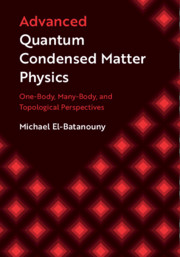Book contents
- Frontmatter
- Dedication
- Contents
- Preface
- Part One One-Electron Theory
- Part Two Topological Phases
- Part Three Many-Body Physics
- 13 Many-Body Physics and Second Quantization
- 14 The Interacting Electron Gas
- 15 Green Functions for Many-Body Systems and Feynman Diagrams
- 16 Path Integrals
- 17 Boson Systems: Bose–Einstein Condensation and Superfluidity
- 18 Landau Fermi Liquid Theory
- 19 Non-Fermi Liquids, the Luttinger Liquid, and Bosonization
- 20 Electron–Phonon Interactions
- 21 Microscopic Theory of Conventional Superconductivity
- 22 Quantum Theory of Magnetism: Exchange Coupling Mechanisms
- 23 Quantum Theory of Magnetism: Magnetic Insulator Ground States and Spin-Wave Excitations
- 24 Quantum Theory of Magnetism: Itinerant-Electron Systems and the Kondo Effect
- References
- Index
21 - Microscopic Theory of Conventional Superconductivity
from Part Three - Many-Body Physics
Published online by Cambridge University Press: 06 March 2020
- Frontmatter
- Dedication
- Contents
- Preface
- Part One One-Electron Theory
- Part Two Topological Phases
- Part Three Many-Body Physics
- 13 Many-Body Physics and Second Quantization
- 14 The Interacting Electron Gas
- 15 Green Functions for Many-Body Systems and Feynman Diagrams
- 16 Path Integrals
- 17 Boson Systems: Bose–Einstein Condensation and Superfluidity
- 18 Landau Fermi Liquid Theory
- 19 Non-Fermi Liquids, the Luttinger Liquid, and Bosonization
- 20 Electron–Phonon Interactions
- 21 Microscopic Theory of Conventional Superconductivity
- 22 Quantum Theory of Magnetism: Exchange Coupling Mechanisms
- 23 Quantum Theory of Magnetism: Magnetic Insulator Ground States and Spin-Wave Excitations
- 24 Quantum Theory of Magnetism: Itinerant-Electron Systems and the Kondo Effect
- References
- Index
Summary
Introduces the concept of Cooper pairing and develops a diagramatic approach to the Cooper instability. The BCS Hamiltonian is then constructed and solved with the aid of the Bogoliubov–Valatin transformation. Nambu–Gorkov formalism is introduced, and the Gor'kov anomalous Green function constructed. The Ginzburg–Landau formulation is derived from microscopic theory using the coherent-state partition function and the HS transformation. Detailed account of the Ginzburg–Landau perspective of superconductivity is given, ending with a derivation of the Meissner effect and an explanation of the Anderson–Higgs mechanism.
- Type
- Chapter
- Information
- Advanced Quantum Condensed Matter PhysicsOne-Body, Many-Body, and Topological Perspectives, pp. 666 - 710Publisher: Cambridge University PressPrint publication year: 2020

